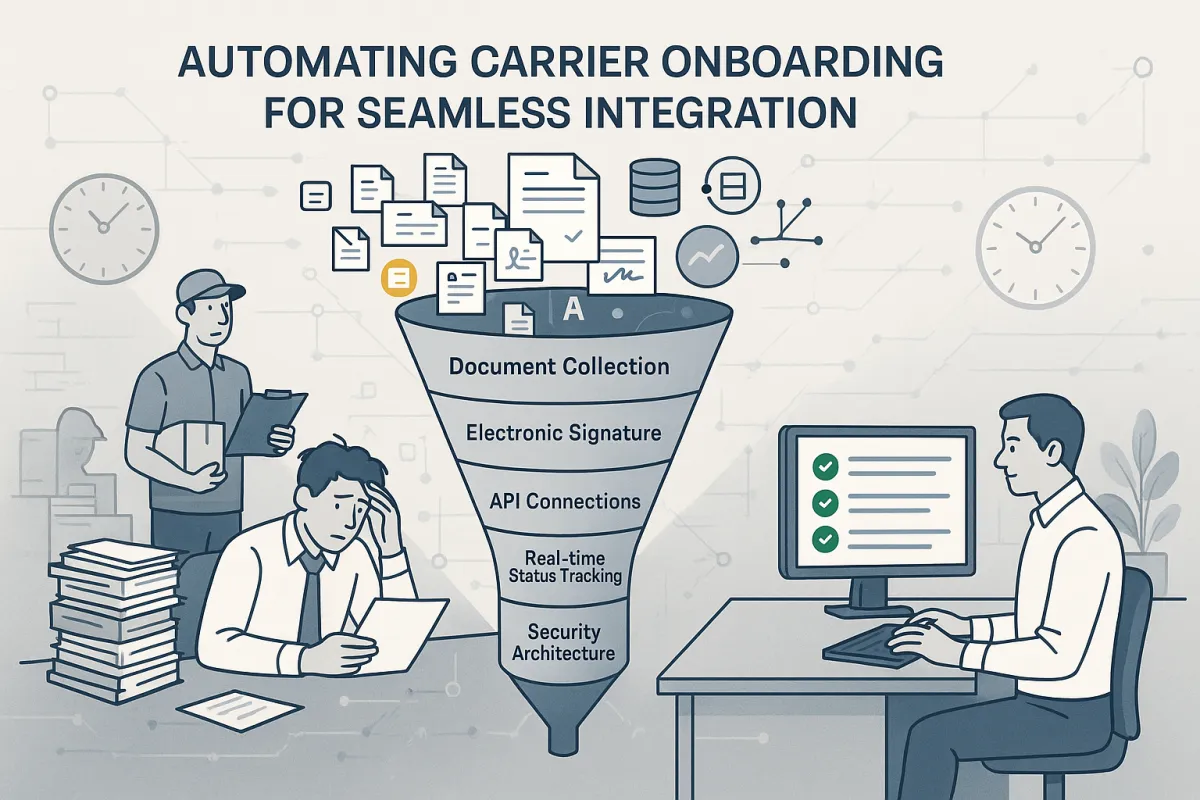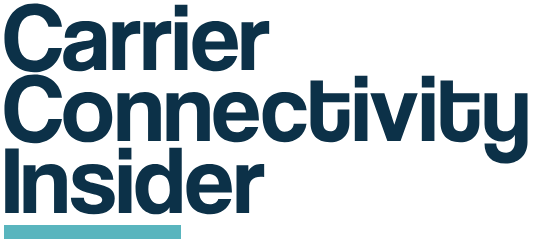Automated Carrier Onboarding: Implementation Guide for 80% Faster Integration Workflows

Manual carrier onboarding is expensive. Automated carrier onboarding processes can deliver up to 80% time savings compared to manual methods, while companies like Shippeo guarantee that 90% of carriers will be onboarded in less than 30 days. For European shippers managing dozens or hundreds of carrier relationships, these numbers represent substantial cost reductions and competitive advantages.
The challenge goes deeper than time savings. Manual processes create bottlenecks that delay capacity access, increase spot market dependency, and expose you to compliance risks. When you can't quickly onboard a new carrier with competitive rates, you're stuck paying premium prices or missing delivery windows entirely.
This implementation guide shows you how to build automated carrier onboarding workflows that reduce manual processes by 80% while maintaining the security and compliance standards required for European operations.
Why Automated Carrier Onboarding Matters for European Shippers
The numbers tell the story clearly. Companies using automated onboarding have reduced costs by half versus doing it in-house, according to testimonials from Max Trans Logistics. But cost reduction is only one benefit.
Speed becomes your competitive weapon. While your competitors spend weeks exchanging emails and chasing certificates, you're securing capacity and moving freight. Automated systems replace unreliable faxes with on-demand documentation and instant electronic signatures, dramatically speeding up processes.
Compliance automation removes another pain point. European shippers face GDPR requirements, varying national transport regulations, and customer audit demands. Automated workflows reduce onboarding errors by 80%, which directly translates to fewer compliance violations and audit findings.
Modern TMS solutions approach this differently. Cargoson includes automated carrier connectivity by default, while platforms like nShift and FreightPOP focus on pre-built integrations. Legacy systems like SAP TM typically require additional modules or third-party solutions for automated onboarding.
Core Components of an Automated Onboarding Workflow
Your automated workflow needs five essential components working together. Each handles specific tasks while feeding data to the next stage.
Document collection systems eliminate the email chase. Set up intake portals where carriers upload insurance certificates, operating licenses, and tax documents. The system validates file formats, checks expiration dates, and flags missing items automatically. No more "did you receive my email?" conversations.
Electronic signature integration accelerates contract execution. Legal documents that took weeks now process in hours. Carriers receive contract links, review terms, and execute electronically. The system tracks signature status and sends automated reminders.
API-first approaches scale better than EDI-based systems. Modern carriers prefer REST APIs for real-time data exchange. Start with API connections for tracking, status updates, and document exchange. Reserve EDI for carriers who specifically require it. Platforms like MercuryGate and Transporeon increasingly support API-first integration strategies.
Real-time status tracking prevents bottlenecks. Dashboard views show exactly where each carrier sits in your pipeline - document review, insurance verification, credit approval, or system integration. Operations teams see delays immediately rather than discovering them during weekly reviews.
Authentication and Security Architecture
Security architecture determines your system's trustworthiness. Always use HTTPS for all OAuth-related traffic, as tokens transmitted over plain HTTP are essentially public information.
OAuth 2.0 implementation provides industry-standard authentication. The most secure API authentication combines OAuth 2.0 with short-lived access tokens and multi-factor authentication. Configure authorization servers to issue tokens valid for 15-30 minutes, forcing regular re-authentication.
Multi-factor authentication adds necessary protection. Enhanced security through MFA identifies compromised credentials and provides single-sign-on experiences. Require SMS or authenticator app verification for sensitive operations like contract signing or banking information updates.
Zero trust principles apply to carrier access. Never assume network location indicates trustworthiness. A centralized OAuth authorization server should always issue access tokens, as only one entity can safely handle complex authentication processes. This differs from Cargoson's integrated approach versus systems requiring separate identity management components.
Setting Up Secure Credential Management
Token lifecycle management prevents security gaps. Always issue tokens with limited capabilities, and verify token scopes at the API gateway to limit attack surface. Configure automatic token rotation every 24-48 hours.
Role-based access controls (RBAC) limit exposure. Create specific roles for carrier onboarding staff, compliance reviewers, and system administrators. Carriers get read-only access to their own onboarding status, nothing more.
Regularly rotate API keys and implement automated key rotation policies to reduce exploitation windows. Document who has access to what systems and review permissions quarterly.
Technical Implementation Steps
Webhook configuration enables real-time updates. Configure carriers to send status notifications to your endpoints when shipments move, documents get updated, or issues arise. This eliminates polling and reduces system load.
Database schema design affects long-term scalability. Create separate tables for carrier profiles, document storage, integration status, and performance metrics. Use foreign keys to maintain relationships but avoid complex joins that slow dashboard loading.
Integration with existing TMS/ERP systems requires careful planning. Modern systems like Cargoson provide APIs for external system integration, while legacy platforms may require middleware or batch processing. Oracle TM and Alpega typically need custom development for automated workflows.
Error handling and fallback procedures prevent system failures from stopping onboarding. When automated document verification fails, route items to manual review queues. When API connections timeout, switch to email notifications with manual follow-up tracking.
Compliance and Risk Management Automation
Insurance verification automation reduces manual checking. Connect to insurance provider APIs or third-party verification services. Set up automatic alerts 30 days before policy expiration. Some carriers update insurance annually - catch these changes before they cause compliance failures.
License and certification monitoring prevents authority violations. Automated systems verify submitted information against industry standards and regulatory requirements. Configure checks against national transport authority databases for operating licenses and safety ratings.
FMCSA safety score tracking applies to US operations but European equivalents exist. Monitor Operator Compliance Risk Score (OCRS) in the UK or similar metrics in other EU countries. Set automatic alerts when scores exceed acceptable thresholds.
GDPR compliance requires specific data handling procedures. Use local servers for data transfers and storage, complying fully with local data management regulations like GDPR in Europe. Document data processing purposes and retention periods. Provide carriers with data access and deletion capabilities.
Solutions like Cargoson handle compliance automatically within their platforms, while larger systems like SAP TM require separate compliance modules or custom development.
Measuring Success and Optimization
Onboarding speed metrics show system efficiency. Track time from initial carrier contact to first shipment tender. Target 5-7 days for simple carriers, 14-21 days for complex international operators requiring additional documentation.
Integration success rates indicate technical performance. Measure API connection establishment, document processing accuracy, and system error rates. Aim for 95%+ success rates in automated processes.
Cost per onboarded carrier reveals ROI. Include staff time, technology costs, and external verification services. B2B customers expect onboarding SLAs with guaranteed timelines - measure your performance against stated commitments.
Time-to-value metrics demonstrate business impact. Track how quickly new carriers begin moving freight after onboarding completion. Extended delays suggest process inefficiencies or carrier adoption problems.
Benchmark against platforms like Cargoson (typically 24-48 hours for API-enabled carriers), nShift (3-5 days), and ShippyPro (varies by carrier complexity) to understand competitive positioning.
Common Implementation Challenges and Solutions
Legacy system integration creates the biggest headaches. Older TMS platforms often lack API capabilities or require expensive customization. Consider middleware solutions or phased migration strategies rather than attempting complete system replacement.
Carrier adoption varies significantly. Modern EDI and API integration platforms eliminate the need for manual intervention or custom scripting with robust, end-to-end integrations. However, smaller carriers may resist technological change. Provide training resources and gradual migration paths.
Data quality problems persist across systems. Carriers submit incomplete documents, use inconsistent naming conventions, or provide outdated contact information. Automated systems flag discrepancies in contact information and prompt further vetting for carriers with significant differences.
Scalability considerations become important as carrier networks grow. Pre-built API and EDI integrations automate supply chain transactions directly into back-office applications. Platforms like Cargoson scale automatically, while custom solutions require infrastructure planning.
Solutions like Cleo's Carrier Relationship Manager help shippers, freight brokers, and 3PLs better manage and strengthen relationships with carriers through transparent performance tracking. E2open/BluJay provides similar functionality through their network management tools.
Remember: Hybrid onboarding combining digital processes with human interaction achieves 73% satisfaction versus 41% for digital-only approaches. Plan for human oversight and intervention capabilities even in highly automated systems.
Start with pilot implementations involving 10-15 key carriers. Perfect your processes with manageable volumes before scaling to your entire carrier network. This approach reduces risk while providing immediate benefits and learning opportunities.
